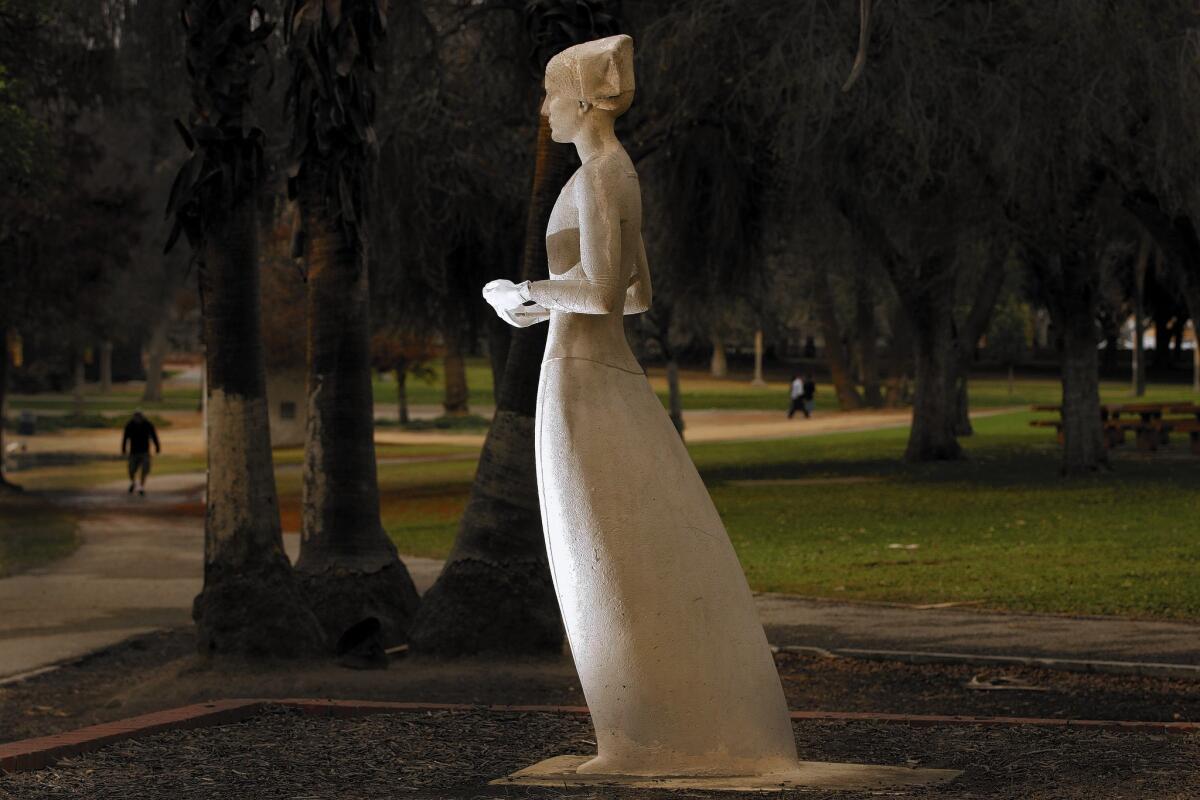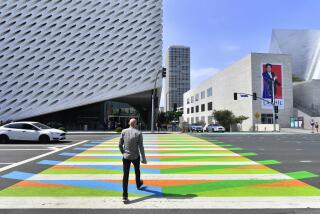Battered Florence Nightingale statue needs critical care

It’s been a tough go for Florence, the stoic, graceful lady of Lincoln Park. Over the years, hooligans have broken her nose, spray-painted her face, shot at her, ripped off her hands and stolen her lamp.
But for all the attempts to deface the statue of Florence Nightingale, the founder of modern nursing stands tall and calm in the spot she claimed in 1937, across the railroad tracks from the county hospital.
I have to admit that I didn’t know the statue was there until I heard from David Colachico, a professor in the nursing school at Azusa Pacific University. For years, he said, the Western Conservancy of Nursing History has been trying to rescue the statue from the battlefield, just as the British nurse Nightingale ministered to wounded warriors in the Crimean war.
The nursing community wants to conserve the statue and move it to the nursing center at the Azusa campus, where, presumably, it would have a more appreciative audience.
But the city of Los Angeles says no.
“Because the sculpture is a city asset, we cannot accommodate your request to relocate the sculpture,” Felicia Filer, director of public art in the Department of Cultural Affairs, wrote to Colachico last summer.
The letter noted that the statue was a permanent gift from the federal Works Progress Administration, and has “significant historical value.” The City Charter doesn’t allow removal without board approval, a highly unlikely prospect, Filer said.
Colachico wrote to Mayor Eric Garcetti seven months ago, asking if he would intervene. No response.
Last week, I met Colachico and retired nurse Joyce Jacob at the statue. And here’s how bad it is for Ms. Nightingale:
The plaque that declares her life “a mighty influence against Man’s cruelty to Man” has been graffitied.
Hideous white, oversized mannequin hands have been crudely tied to the statue where the originals were hacked off.
Let’s just say she no longer looks like the statue pictured in a brochure that Jacob brought along from the 1937 unveiling, which was attended by dignitaries and nursing school representatives.
“She’s so beautiful. She’s so graceful,” Jacob said of the statue in the photo.
The park was beautiful then, a well-manicured oasis. But time hasn’t been kind to it, either. And when I checked the statues at the other end of the park, they were in no better shape than Nightingale. Plaques are missing from busts, creating a sad gallery of anonymous, forgotten heroes.
The city’s public art staff tells me that there has been no “significant maintenance” on Florence Nightingale since 1999. And if you’re having trouble guessing the stated reason, here you go:
“In recent years there has not been, nor is there currently, a dedicated budget for the maintenance of this and other statues,” said an email from city staff.
I can understand why, in the best of times, the city wouldn’t want to relinquish its public art. But if a statue is an asset with significant value, as the city states, it should either find a way to take better care of its own history or open the door and let someone else help.
As we stood at the statue, I realized that in the distance, I could see the hospital where I flat-lined a year and a half ago after surgery, and was resuscitated by a nurse. So I guess you could say I owe a debt to Florence and her descendants.
A lot of nurses, Jacob said, were inspired by Nightingale to enter the profession, which is why she wants to see the statue conserved.
“We’ve been fighting this since 1974,” she said, referring to the alumni association of the now-defunct California Hospital School of Nursing, from which she graduated in 1960.
Colachico, in fact, pointed out a Los Angeles Times column written in 1974 by none other than the legendary Jack Smith. The column was accompanied by a photo of young students in traditional nursing garb, white swan hats included.
And like me, Smith was outraged:. “Her nose was smashed. The hands had been broken off her out-thrust arms,” wrote Smith. “Her breast and skirt were stained with graffiti. Yet her spirit seemed undiminished. She had triumphed over her tormentors.”
That was 40 years ago, and at the time a city commission agreed to let a nursing group restore the statue. If it was again defaced, the board promised to attempt to move it to “a safe public place.”
Well, Florence is still waiting.
If the Cultural Affairs Commission won’t let her move to Azusa Pacific, it should at least consider a safer home than the one she’s in. County-USC Medical Center and Keck Hospital of USC are across the street, both with round-the-clock security. Andrea Morse of Sculpture Conservation Studio noted that private donors can sponsor conservation projects, and she guesses $5,000 to $10,000 worth of surgery would give Nightingale a second life.
And 2.5 miles from the statue is the campus of Florence Nightingale Middle School. The principal, Patty Heideman, told me she would love to explore ways for her students get involved in rescuing their school’s namesake.
As for Azusa Pacific, I asked Colachico why the school couldn’t commission its own statue. It could, he said, but this isn’t about having their own Florence Nightingale. It’s about rescuing the one who’s been waiting decades for someone to come to her aid.
More to Read
Start your day right
Sign up for Essential California for news, features and recommendations from the L.A. Times and beyond in your inbox six days a week.
You may occasionally receive promotional content from the Los Angeles Times.







